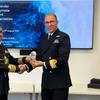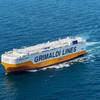SATCOM Battle Heats Up
Prior to the introduction of radio, maritime communication was generally limited to line-of-sight visual signaling during clear weather, plus noise-makers such as bells and foghorns. The advent of radio greatly reduced the isolation of ships during emergencies and was quickly responsible for saving thousands of lives. The first ship-to-shore, two-way radio conversation reportedly occurred in 1922, between Deal Beach, N.J., and the S.S. America, 400 miles at sea.
Fast forward more than eight decades and the communication-at-sea scene is drastically different. Still touted as a major factor in improving safety-at-sea, modern communication service and technology have much more to offer. While ship owners and managers are notorious for Draconian cost cutting and control, even some of the most frugal owners are finding that high-speed voice, fax and data services can help to make the transport of cargo and passengers more efficient and cost effective. While safety and efficiency still top the list, the additional benefits are numerous.
For example, innovative crew calling and crew e-mailing programs are geared toward gaining and retaining shipboard personnel. Telephone and Internet at sea offerings for large passenger vessels are established as a profit center, and a necessity to keep information-hungry passengers connected. Seamless broadband "always on" service is an indispensable tool for the scientific and business communities alike, as the ability exists to quickly and efficiently push large amounts of data from ship to shore and back.
The pace of technological innovation continues to pick up speed, and the lag between today's best and the "next generation" is growing increasingly homogenous. That said, the next generation in maritime satellite communications is coming at the end of this year, as the enhanced capabilities of the BGAN system are made possible through a new generation of satellites known as Inmarsat 4 (I-4), the first of which was successfully launched in March 2005.
Market Drivers
In discussing the market with several leading service providers, a consensus emerged as to the critical factors: service, quality and speed.
"Our success strategy is driven by our key strengths, that being that we are an entrepreneurial company operating close to the industry; an innovative company launching new products and services demanded by the end user and our distributers," said Erik Ceuppens, CEO, France Telecom. France Telecom has been particularly adept at developing products to facilitate the speedy and successful transmission of data, as its Skyfile software is able to compress data up to 90 percent. Combined with an aggressive promotion agenda, such as a strong initiative to promote crew calling, France Telecom has enjoyed an annual growth rate of nearly 18 percent. Ronald Spithout, Executive Vice-President Marketing & Sales, Xantic, also cites quality and availability as keys to success. "Big ship managers, those that have 300 to 400 large vessels, demand quality, availability and uniform global service," he said. "Being global is the key."
Maritime Telecommunications Network (MTN) has three core market segments: cruise, oil & gas, and the military.
According to David Kagan, President and CEO, MTN, the company is currently targeting two underserved markets: the superyacht and the casino boat markets. Kagen echoes his colleagues in citing reliability and quality as ultimate measures of success. He also points to an innovative joint venture with Cingular Wireless, a venture to provide mobile phone services on vessels in an affordable manner, as an exciting new offering for MTN, and a big technology driver for the future of the company, particularly in its cruise niche. Kagan had a 10-year stint as an executive with Norwegian Cruise Lines, experience as a satellite communication customer he uses to make MTN more relevant to its customers. "It has had a dramatic impact on the way in which they run their business, and the offshore oil and gas business is really starting to grasp this. Live credit card verifications; monitoring the wear and tear on engine parts; booking future business; and clearing customs per new protocols."
A big driver for the integration of new and improved satellite communications service has been maritime security initiatives, perhaps none more important than the new U.S. Coast Guard's "Notices of Arrivals and Departures," said Xantic's Spithout. To fill the need, Xantic launched AMOS Connect, specifically geared to handle the new security mandate, and it is offered to customers for free.
He maintains that the continued advances in service and speed, in and of itself, will be a driver for changes in communication behavior. "Two or three years ago, there were still a number of analog terminals, and they will soon disappear." He said that Xantic noticed when companies switched to higher speed service and equipment, usage patterns — ie. voice and fax traffic — held steady for about the first month. But as customers became more familiar and aware of the capabilities, usage changed dramatically, with internet browsing, e-mailing and downloading of maps, to name a few. "It's becoming a floating office. Before making the switch they are often afraid that communications costs will soar." But more and more they realize that features such as crew calling and e-mail is a great way to get and keep employees. We also offer the shipping companies many tools to effectively limit and manage usage. Competition "It is a very tough and competitive business, as the customers are focused so much on price," said MTN's Kagan. He cited a number of good competitors, but said that several newer players' push for market share over profitability — willing to take little or no margin — have had a bad effect on all providers. He believes that there are too many players in the niche, and that there will be additional market consolidation in the coming three to five years. "These types of things always shake-out." "Maritime communications is, and always will be a "niche" market," said Bo Norton, Director of Sales for the Americas, Telenor Satellite Services. "Continued consolidation of satellite communications providers is inevitable and there will be new players trying to expand their reach into the maritime sector from other communications industries such as land mobile or aeronautical. Some examples of this today include expanded service offering in the maritime field by Iridium, the targeting of the maritime industry by Connexion by Boeing and even the Telenor Satellite Services' partnership with equipment manufacturer Sea Tel. In addition, technological advances will also make it increasingly difficult for some satellite service providers to satisfy the demand for expanded throughput and capacity using smaller equipment and offering expanded service portfolios that target a broader spectrum of the maritime industry. Some will just not be able to maintain profitability while keeping their prices for these services competitive." "There seems to be a lot of competitors in market selling broadband services," said said Don Thoma, Executive Vice President, Vertical Market Services, Iridium. "Due to the cost sensitive nature of the industry, these companies will primarily be competing on price. The satellite communications industry is a high fixed cost industry. Any significant price reduction in these services will most likely force one or two of the broadband player out of the business or to consolidate." Expanding on the price sensitivity, Thoma continued. "The maritime market is a very price sensitive market and the ship management companies and owners are continually looking for ways to reduce costs of operations and improve services for their ships. The operators are looking to get more capability for their communications budget or better reduce the cost of communications. To serve the maritime market, Iridium has offered a packaged solution that combines a set of capabilities in an affordable communications solution. Typically ship operators are interested in:
• In-network calling capability
• E-mail and data services
• Crew-Calling As with any technology, it is incumbent upon the providers to communicate with their customers the benefits of usage. "Satellite communications companies must effectively communicate to the maritime industry how their services can increase the efficiency of business operations at sea while at the same time show how communications impact on the company's bottom line," said Bo Norton, Director of Sales for the Americas, Telenor Satellite Services. "While online account management tools are becoming a standard 'value added service' offering, communications officers must be able to easily understand and use them. Satellite communications at sea must be realized by maritime decision-makers as an operational business tool that saves the company money. The challenge for satellite communications companies is to provide maritime users these advanced applications and greater bandwidth at a competitive price while maintaining profitability."











